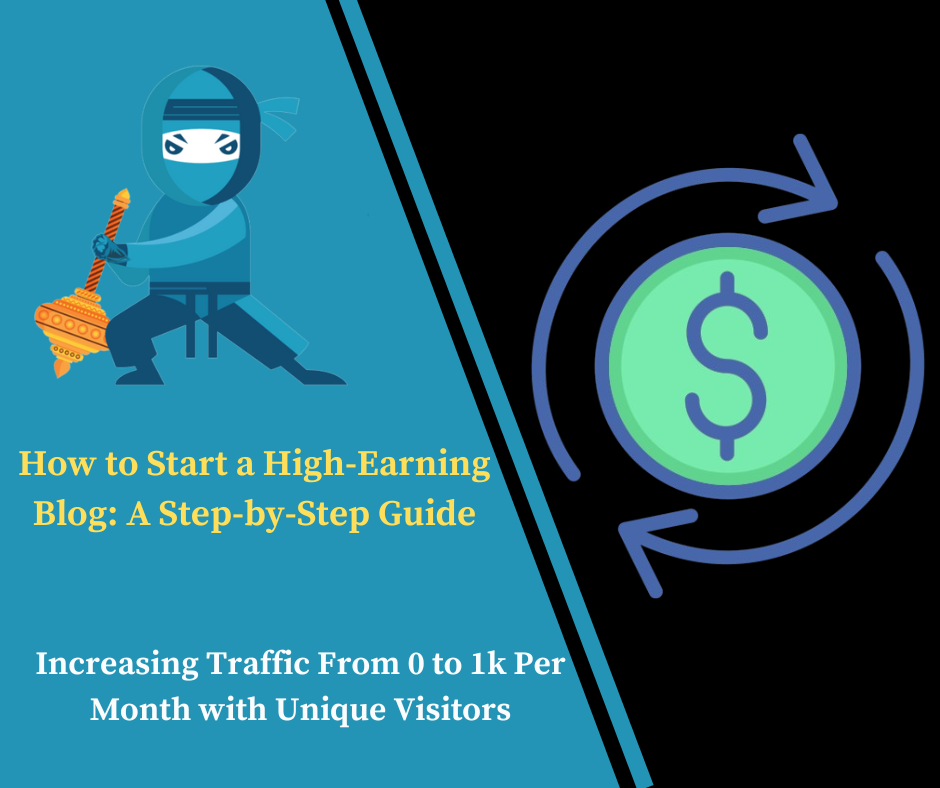How to Start a High-Earning Blog: A Step-by-Step Guide
In the digital age, blogging has evolved from a personal pastime into a lucrative business opportunity. Many aspiring bloggers dream of creating a high-earning blog that reaches a wide audience and generates substantial income. However, turning this dream into reality requires a strategic approach and a solid understanding of monetizing your blog effectively. This step-by-step guide will walk you through the essential steps to start a high-earning blog, from selecting a profitable niche to implementing successful monetization strategies. Following this comprehensive guide, you’ll be well-equipped to launch a blog that can achieve significant financial success.
Starting a high-earning blog is an exciting journey that combines passion with the potential for substantial income. If you’re eager to turn your blogging ambitions into a profitable venture, this step-by-step guide will walk you through the process. From choosing a niche to monetizing your content, you’ll learn how to build a blog that not only attracts readers but also generates revenue.
Step 1: Choose a Profitable Niche
Finding Your Niche
The first step to creating a high-earning blog is selecting a niche that has both interest and earning potential. A profitable niche typically aligns with your passions and has a large, engaged audience. Conduct thorough research to identify niches with high demand and low competition.
Keyword Research: Use tools like Google Keyword Planner or Ahrefs to find high-value keywords within your niche. Focus on keywords with high search volumes and manageable competition.
Market Analysis: Look into current trends and audience needs. Use forums, social media, and competitor blogs to gauge what topics resonate most with your target audience.
Why Niche Selection Matters
A well-chosen niche allows you to cater to a specific audience, which is crucial for building a loyal readership. It also helps in targeting your content and monetization strategies effectively.
Step 2: Develop a Business Plan
Setting Clear Goals
Creating a business plan is essential for managing your blog’s growth and success. Outline both short-term and long-term goals to keep your efforts focused.
Short-Term Goals: These might include launching your blog, publishing your first ten posts, and reaching your first 1,000 visitors.
Long-Term Goals: Consider goals like reaching a specific monthly income, growing your subscriber list, and expanding your content offerings.
Monetization Strategies
Decide on how you plan to monetize your blog. Some common methods include:
Advertising: Use networks like Google AdSense or sell ad space directly to brands.
Affiliate Marketing: Promote products or services and earn commissions on sales made through your referral links.
Sponsored Posts: Collaborate with companies to create content featuring their products or services.
Selling Products/Services: Offer digital products like e-books, courses, or consulting services
Budget Planning
Consider initial expenses such as domain registration, hosting, and premium themes or plugins. Setting a budget helps manage your finances and ensure you have the resources needed for a successful launch.
Step 3: Choose a Domain Name and Hosting
Selecting a Domain Name
Your domain name is your blog’s identity on the web. Choose a name that is:
Memorable: Easy to remember and spell.
Relevant: Reflects on your niche and content.
Keyword-Rich: Incorporates relevant keywords if possible.
Choosing a Hosting Provider
Reliable hosting ensures your blog runs smoothly and remains accessible to readers. Look for a hosting provider that offers:
Uptime Guarantee: Ensure minimal downtime to keep your blog accessible.
Speed: Fast loading times for better user experience and SEO.
Customer Support: Reliable support for troubleshooting issues.
Step 4: Set Up Your Blog
Installing a CMS
A Content Management System (CMS) like WordPress is ideal for beginners due to its user-friendly interface and extensive
Choosing a Theme
Select a theme that is both aesthetically pleasing and functional. Your theme should be:
Responsive: Mobile-friendly design to cater to all devices.
Customizable: Allows for personalization to match your brand.
Essential Plugins
Install plugins to enhance your blog’s functionality. Key plugins include:
SEO Plugins: Optimize your content for search engines (e.g., Yoast SEO).
Security Plugins: Protect your blog from threats (e.g., Wordfence).
Performance Plugins: Improve loading times and user experience (e.g., WP Super Cache).
Step 5: Create Quality Content
Crafting Engaging Posts
High-quality content is crucial for attracting and retaining readers. Focus on:
Value: Provide useful, informative, and actionable content.
Readability: Use clear headings, bullet points, and visuals to enhance readability.
Consistency: Maintain a regular posting schedule to keep your audience engaged.
SEO Optimization
Optimize your posts for search engines to increase visibility. Include:
Keywords: Use relevant keywords throughout your content.
Meta Tags: Write compelling meta titles and descriptions.
Backlinks: Build backlinks to boost your content’s authority.
Step 6: Promote Your Blog

Utilizing Social Media
Social media platforms are powerful tools for driving traffic to your blog. Share your posts on:
Facebook: Engage with groups and communities relevant to your niche.
Twitter: Use hashtags and participate in conversations.
Instagram: Share visual content and interact with followers.
Building an Email List
Email marketing is essential for nurturing relationships with your readers. Offer incentives, such as exclusive content or free resources, to encourage sign-ups.
Networking with Bloggers
Connect with other bloggers and influencers in your niche. Guest posting and collaborations can help you reach a broader audience and build your blog’s authority.
Step 7: Monetize Your Blog
Implementing Monetization Strategies
Apply the monetization strategies outlined in your business plan:
Advertising: Set up ad placements and monitor performance.
Affiliate Marketing: Integrate affiliate links naturally within your content.
Sponsored Content: Create sponsored posts and track their effectiveness.
Product Sales: Launch and promote your products or services.
Diversifying Income Streams
Explore multiple revenue sources to maximize earnings. Combining various strategies can provide a more stable income stream and reduce dependency on a single source.
Also read: 10 Proven Techniques to Boost Your Product Sales Conversion
Step 8: Analyze and Optimize
Tracking Performance
Use analytics tools like Google Analytics to monitor your blog’s performance. Track metrics such as:
Traffic: Number of visitors and page views.
Engagement: Time spent on site and bounce rate.
Revenue: Earnings from different monetization methods.
Making Data-Driven Decisions
Analyze your data to identify what works and what doesn’t. Adjust your content, promotion, and monetization strategies based on your findings to continually improve your blog’s performance.
FAQ
How long does it take to start earning from a high-earning blog?
It typically takes several months to start generating significant income from a blog. Building an audience, creating quality content, and implementing monetization strategies all take time.
What are the initial costs associated with starting a high-earning blog?
Initial costs can include domain registration, hosting, premium themes, and plugins. On average, these costs can range from $100 to $300, depending on your choices.
How often should I publish new content to maximize earnings?
Consistency is key. Aim to publish new content regularly, such as once a week or bi-weekly, to keep your audience engaged and improve SEO.
Can I start a high-earning blog without investing a lot of money?
Yes, you can start a blog with a limited budget. Many blogging platforms offer free options, but investing in a domain and hosting can provide more control and professionalism.
What are the most effective ways to promote a high-earning blog?
Effective promotion strategies include leveraging social media, building an email list, and networking with other bloggers and influencers.
Conclusion
Starting a high-earning blog is a rewarding endeavor that requires careful planning and strategic execution. By choosing a profitable niche, developing a solid business plan, and focusing on quality content and effective promotion, you can build a successful blog that generates significant income. Stay consistent, analyze your performance, and adapt your strategies to continually grow your blog’s earnings and impact.








